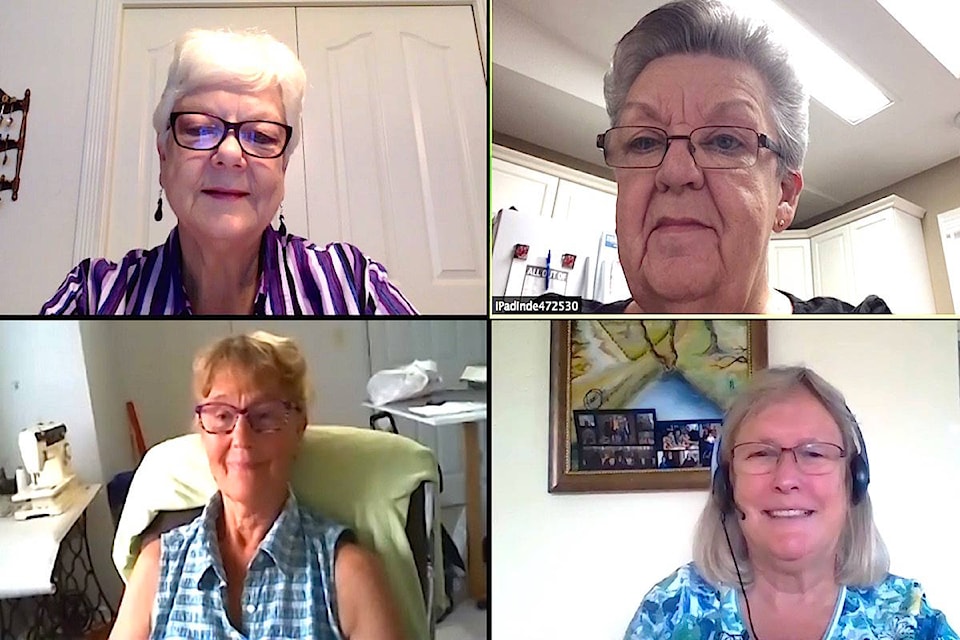It’s a little tricky being a “neighbourhood connector” trying to reduce the crippling isolation of seniors during a global pandemic.
Barbara Miller, Linde Cherry, and Judith Knowles are working to do just that, as part of a pilot project led by the Compassionate Neighbourhood Health Partners Society.
So how does this vital work carry on in the face of 2020 obstacles? The answer is very carefully.
It helps to know what a “neighbourhood connector” does.
“A neighbourhood connector can be the glue for the neighbourhood,” explained Connie Stam, co-ordinator of the Compassionate Neighbourhood Health Partners Society, which spearheaded the project in March 2018.
Connectors are specially trained volunteers helping seniors in their neighbourhood who may need a hand with a range of concerns or a friendly chat. They may struggle with chronic illnesses, or depression, and need referrals to the right agency. The connectors are trained in active listening, and recognizing the signs of elder abuse.
As a group in a given neighbourhood, they get to know each other through socializing, and they watch out for each other.
That caring-and-sharing narrative has been replaying itself across Chilliwack as part of a pilot ‘Neighbourhood Activation Project.’ The “neighbourhoods” take a range of forms: an apartment complex, a gated community, or a cul-de-sac as examples.
Interconnectedness that grows out of the interactions between neighbours is what improves the participants’ quality of life. Often it’s just a simple act of kindness when it is needed the most.
When co-ordinator Connie Stam started this kind of compassionate work in her own neighbourhood, she discovered there were seven widows living on one small street.
“They held a coffee social, and it started a habit of looking out for one another.”
However, the pandemic has meant that coffee socials and in-person gatherings had to be curtailed, when social distancing wasn’t possible. Regular happy hour gatherings turned into once monthly, with protocols in place.
It is clear that this simple interconnectedness is what actively improves the participants’ quality of life, and the trained volunteers also have resources at their fingertips to share.
Barbara Miller lives in a 55-plus building. She discovered that two-thirds of the units were owned by single women.
So she took the idea of neighbourhood “connecting” and presented it to the strata council. They took it upon themselves to ensure that every resident in the building was paired with someone who would check in on them.
“So if someone got hurt in the night, there would be someone to check in with them the next day. That’s the way to bolster their sense of community and security,” Miller said.
They started hosting regular happy hour sessions, but COVID-19 put a stop to those.
“But I realized how valuable they were,” Miller said.
So they worked out a way to continue enjoying some physically distanced gatherings.
Linde Cherry lives in a gated community with 120 units, in which most are elderly single women, all 55-plus, where they started a Tuesday morning coffee group.
There’s a clubhouse where they used to hold events. It shut down with the advent of COVID-19 but instead of ending completely, it just shifted gears.
“The phone replaced our visits,” Cherry said. “I think it has everyone thinking outside the box, about how to communicate. We realized you don’t have to gather in big group to stay in touch with your neighbours.”
They held some distanced outdoor visits when the weather was still good. They’d enjoy a coffee and a chat on the lawn, spread out in lawn chairs. But the series of restrictions subsequently brought in have had an impact.
One woman who was in hospital had a dog that needed care. There were residents who stepped forward to care for the dog.
“There’s a lot more connecting going on,” Cherry said.
Judith Knowles moved out of her long-time home and into an apartment restricted to older adults, and found herself the “newbie” among the veteran residents of the building, many of whom had lived there 20 years.
Knowles had embraced the society, and tried to start a group with the residents, but there wasn’t too much interest initially.
“As time went on, some of them warmed up to it,” Knowles said, adding that now she co-ordinates a group of about six.
She assists a gentleman with early dementia, calling him occasionally, and another lady gets a weekly call.
Sometimes they’ll meet up on the parking lot, share some fresh baking, or a small bouquet of flowers.
“We’ll linger there and have a visit that way, or we’ll gather in the lobby,” Knowles said. The lobby is also good for posting messages folks can read and find vital information.
One gentleman who was a contractor in the building was diagnosed with cancer and felt lost. He was able to benefit from being referred to services offered by the society and other agencies that could help.
All of that was because Knowles had taken the neighbourhood connector training.
“I feel I have the answers or, if not, I know I could call on the co-ordinator for help finding them,” she said.
The whole concept of neighbourhood connection work is filling in the gaps and supporting each other.
“The vision is that every neighbour will feel supported in their neighbourhood,” Stam added. “That’s what we’re striving for.”
Of course not everyone wants to socialize. But if they are feeling the pang of isolation, there’s someone there, most willing to commit a simple act of kindness.
To find out more about the pilot project, or to register for the training to become a neighbourhood connector, call Connie Stam 604-798-2023, email neighbourhealth@gmail.com, www.cnhpsociety.com
READ MORE: Volunteers and neighbourhoods needed for pilot project
READ MORE: Gatherings (pre-COVID) to break down isolation
Do you have something to add to this story, or something else we should report on? Email:
jfeinberg@theprogress.com
@CHWKjourno
Like us on Facebook and follow us on Twitter.
Want to support local journalism during the pandemic? Make a donation here.
